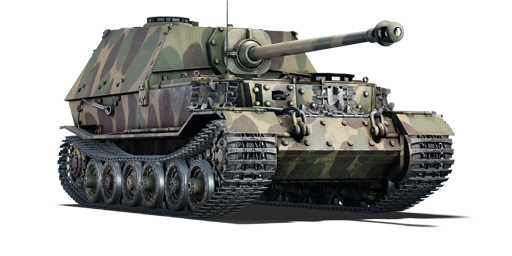


At the conclusion of the Battle of Kursk, the German experience with the Ferdinand had been disappointing due to the constraints the large and heavy vehicle imposed, as well as desired improvements that needed to be implemented to the design. Recalled back to the factories in January 1944, the Ferdinand underwent design improvements such as the inclusion of a bow machine gun, a commander's cupola, application of zimmerit and other changes to the armour profile for better blast and shrapnel protection of the engines. These modifications were completed and began to be sent back into combat as early as February. By May 1944, an order was made by German Army High Command that the Ferdinand was to assume the new name "Elefant". The Elefant continued to see use, notably in the Italian Theatre and the Eastern Front, all the way until the Battle of Berlin in 1945.
The Elefant (Sd.Kfz. index: Sd.Kfz. 184) was introduced during Update "Wind of Change" as reward for Battle Pass: Season VII, "Armoured Elephant". Aside from the addition of the machine gun and cupola, the vehicle is functionally the same as the standard Ferdinand, boasting the long 88 mm PaK 43 cannon to penetrate all types of armour and an impressive 200 mm frontal plate for protection. However, the Elefant is big, heavy, and slow, so being outnumbered by the enemy can quickly lead to a lucky few of them to outflank and destroy the Elefant through its very long side profile, where the armour is thin, or the protruding casemate structure, where the ammunition is stored. However, players maximizing the Elefant's long-range capabilities can quickly lock down a sector of the map from anyone who dares roll into the 88 mm's sight.
| Ammunition | Type | Armor penetration (mm) at a distance: | |||||
|---|---|---|---|---|---|---|---|
| 10 m | 100 m | 500 m | 1000 m | 1500 m | 2000 m | ||
| APCBC | 237 | 234 | 222 | 207 | 193 | 180 | |
| HE | 19 | 19 | 17 | 16 | 14 | 14 | |
| HEAT | 110 | 110 | 110 | 110 | 110 | 110 | |
| APCR | 279 | 273 | 252 | 227 | 205 | 185 | |
| Belt | Belt filling | Armor penetration (mm) at a distance: | |||||
|---|---|---|---|---|---|---|---|
| 10 m | 100 m | 500 m | 1000 m | 1500 m | 2000 m | ||
| AP/AP/AP-T | 13 | 12 | 7 | 3 | 2 | 0 | |







 2 x (135 / 210 / 250) %
2 x (135 / 210 / 250) % 
 2 x 184 %
2 x 184 % 

Mobility | |
|---|---|
Protection |
|---|
Firepower | |
|---|---|